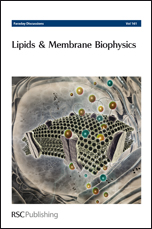Cell cycle dependent changes in membrane stored curvature elastic energy: evidence from lipidomic studies†
Abstract
One of the most developed theories of phospholipid homeostasis is the intrinsic curvature hypothesis, which, in broad terms, postulates that cells regulate their lipid composition so as to keep constant the membrane stored curvature elastic energy. The implication of this hypothesis is that lipid composition is determined by a ratio control function consisting of the weighted sum of concentrations of type II lipids in the numerator and the weighted sum of concentrations of Type 0 lipids in the denominator. In previous work we used a data-driven approach, based on lipidomic data from asynchronous cell cultures, to determine a criterion that allows the different lipid species to be assigned to the set of type 0 or of type II lipids, and hence construct a ratio control function that serves as a proxy for the lipid contribution to total membrane stored curvature elastic energy in vivo. Here we apply the curvature elastic energy proxy to the analysis of lipid composition data from synchronous HeLa cells as they traverse the cell cycle. Our analysis suggests HeLa cells modify their membrane stored elastic energy through the cell cycle. In S-phase type 0 lipids are the most abundant, whilst in G2 type II lipids are most abundant. Changes in our proxy for membrane stored elastic energy correlate with membrane curvature dependent processes in the HeLa cell around division, providing some insights into the interplay between the individual lipid and protein contributions to membrane free energy.
- This article is part of the themed collection: Lipids & Membrane Biophysics

 Please wait while we load your content...
Please wait while we load your content...